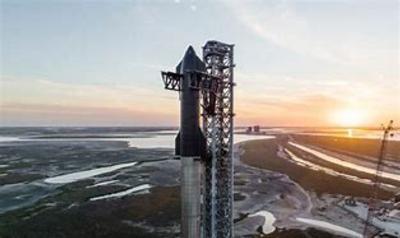History’s Largest, Most Powerful Spacecraft MAY Launch 17 April
The Federal Aviation Administration, on Friday, 14 April 2023, granted SpaceX final regulatory approval to carry out the first orbital flight test of the company’s Starship super-heavy-lift launch vehicle.

The inaugural space-flight MAY see the Starship SN24 prototype blasted spaceward atop SpaceX’s Super Heavy Booster-7 on Monday, 17 April 2023 at 07:00 CDT. The mission will launch from SpaceX’s Starbase facility in Boca Chica, Texas.
In a statement, the FAA set forth: “After a comprehensive license evaluation process, the FAA determined SpaceX met all safety, environmental, policy, payload, airspace integration, and financial responsibility requirements. … The license is valid for five-years.”
In a statement of its own, SpaceX declared: "Starship is a fully reusable transportation system designed to carry both crew and cargo to Earth orbit, help humanity return to the Moon, and travel to Mars and beyond. With a test such as this, success is measured by how much we can learn, which will inform and improve the probability of success in the future as SpaceX rapidly advances development of Starship."
Currently, the forecast for the launch is favorable, calling for moderate winds and clear skies. In the event SpaceX elects to scrub the mission, backup launch attempts may be made on 18 and 19 April.
For its debut launch, Starship will lift off from its Starbase pad, but not attempt to land. Instead, the Super Heavy booster will separate about three-minutes into flight and aim to splash-down in the Gulf of Mexico.
The Starship vehicle, by dint of its sextet of Raptor engines, will continue spaceward, reaching a velocity that will carry it around the world toward a targeted splash-down point in the central Pacific Ocean. Assuming nominal performance of the spacecraft and non-interference from weather, Divine wrath, or similar forces majeures, the entire flight, from lift-off to splash-down, should span approximately ninety-minutes.

Starship’s maiden orbital flight occasions the culmination of an iterative and incremental developmental process comprising frequent prototyping, testing, and refinement. The FAA, over the course of Starship’s maturation, has been less than a friend to SpaceX. In addition to incessantly scrutinizing the mammoth launch-vehicle’s design, flight protocols, and predicted performance, the FAA conducted a pedantic, conceivably overreaching environmental assessment of SpaceX’s Boca Chica Starbase, the results of which compelled the agency, in June 2022, to task SpaceX with the completion of 75 discrete actions intended to safeguard the wetlands adjacent its south Texas Starbase and the wildlife indigenous thereto.
To the subject of Starship’s inaugural space launch, SpaceX founder Elon Musk tweeted: "Success maybe, excitement guaranteed!"
Echoing Mr. Musk’s guardedly optimistic tenor, SpaceX stated in its Starship mission overview: "As is the case with all developmental testing, this schedule is dynamic and likely to change, so be sure to stay tuned to our social media channels for updates. … As we venture into new territory, we continue to appreciate all of the support and encouragement we have received from those who share our vision of a future where humanity is out exploring among the stars!"
SpaceX’s Starship is a remarkable machine, a 390-foot-tall behemoth with a payload capacity of 330,000-pounds to Low Earth Orbit (LOE) in its fully reusable configuration, and 550,000-pounds to LOE if fully expended.
Starship is a composite vehicle consisting of an expendable, for now, Super Heavy booster, first stage and a reusable, Starship, second stage. The 230-foot-tall, 30-foot-wide Super Heavy booster section is powered by 33 of SpaceX’s proprietary Raptor engines arranged in concentric rings. At full-power, the stage’s complement of Raptor and Raptor Vacuum engines produces a staggering 17,100,000-pound-feet of thrust—equivalent, more or less, to 75 Boeing 777-300ERs at full take-off power.
The Starship second stage is 160-feet-tall, 30-feet in diameter, and fitted with three Raptor atmospheric and three additional Raptor Vacuum engines. The section’s 56-foot-tall by 26-foot diameter payload bay boasts an internal volume of 35,000-cubic-feet—slightly larger than the entirety of the International Space Station's pressurized volume. The Starship second stage functions as a self-contained spacecraft within which crew and cargo will journey into space.
Stacked and fueled, Starship’s first and second stages mass approximately 11,000,000-pounds.
Proposed applications of SpaceX’s Starship include supporting construction of the Starlink internet constellation, performing suborbital point-to-point flights, and conveying space-travelers to the surfaces of the Earth’s moon and Mars.
 Sierra Space Repositions Dream Chaser for First Mission
Sierra Space Repositions Dream Chaser for First Mission ANN's Daily Aero-Term (05.10.24): Takeoff Roll
ANN's Daily Aero-Term (05.10.24): Takeoff Roll Aero-News: Quote of the Day (05.10.24)
Aero-News: Quote of the Day (05.10.24) Aero-News: Quote of the Day (05.11.24)
Aero-News: Quote of the Day (05.11.24) ANN's Daily Aero-Term (05.11.24): IDENT Feature
ANN's Daily Aero-Term (05.11.24): IDENT Feature




